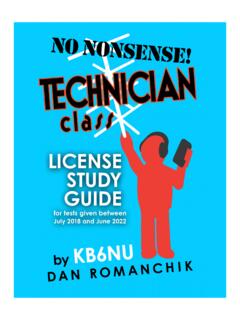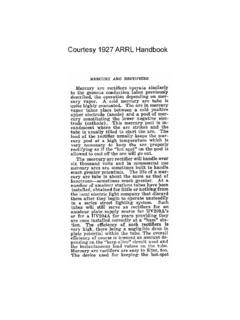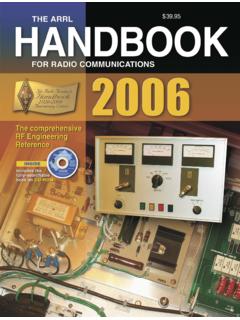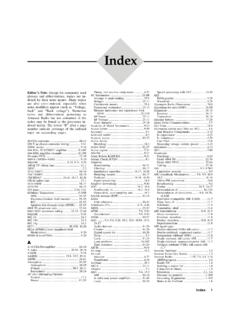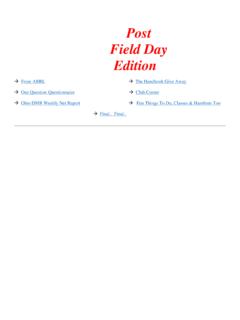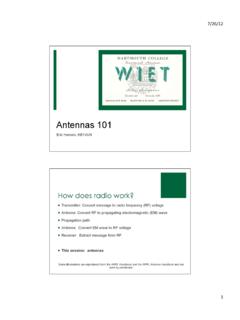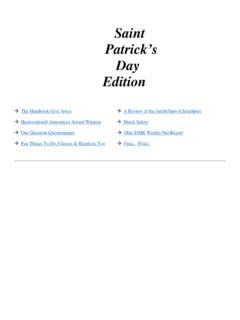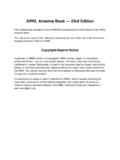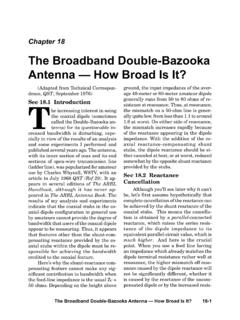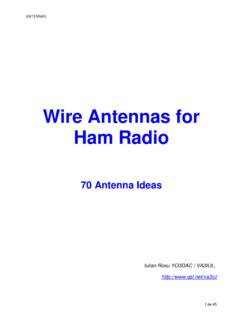Transcription of 2014 No-Nonsense Technician Class Amateur Radio License ...
1 The No-Nonsense , Technician ClassLicense Study Guidefor tests given betweenJuly 2014 and June 2018 Dan Romanchik KB6 NUCopyright 2014 Daniel M. RomanchikAll rights reserved. No part of this publication may be reproduced, stored in a retrieval system,or transmitted in any form or by any means, electronic, mechanical, recording or otherwise, without the prior written permission of the , 3/7/2015 Table of ContentsWhat is Amateur (ham) Radio ?..1 How do you get into Amateur Radio ?..1 How much does it cost?..1 Where do I take the test?..1 Can I really learn how to be an Amateur Radio operator from a study guide like this?..1 How do I use this study guide?..2 Good luck and have principles: math for electronics, electronic principles, Ohm s principles, units, and terms: current and voltage, conductors and insulators, alternating and direct current, resistance, s Law: formulas and principles: DC power for electronics: conversion of electrical units, decibels, the metric principles and components: resistors, capacitors and capacitance, inductors and inductance, : basic principles and applications of solid state devices, diodes and transistors.
2 7 Circuit diagrams, schematic symbols, component wave characteristics: properties of Radio waves, propagation , wavelength, the electromagnetic wave characteristics, how a Radio signal travels, propagation and types, antenna : types of feedline, wave ratio and antenna Radio modes, signal modes: packet, safety: AC and DC power circuits, antenna installation, RF circuits and hazards: hazardous voltages, fuses and circuit breakers, grounding, lightning protection, battery safety, electrical code safety: tower safety, erecting an antenna support, overhead power lines, installing an hazards: radiation exposure, proximity to antennas, recognized safe power levels, exposure toothers, radiation types, duty Radio practices and station setup: connecting microphones, reducing unwanted emissions, power source, connecting a computer, RF grounding, connecting digital controls: tuning, use of filters, squelch function, AGC, repeater offset, memory , transmitters, transceivers, modulation, transverters, low power and weak signal operation, transmit and receive transmitter and receiver problems: symptoms of overload and overdrive, distortion, causes of interference, interference and consumer electronics, part 15 devices, over and under modulation, RF feedback, off frequency signals, fading and noise, problems with digital communications repair and testing: soldering; using basic test instruments.
3 Connecting a voltmeter, ammeter, or service: emergency and non-emergency operations, applicability of FCC rules, RACES and ARES, net and traffic procedures, emergency satellite operation, Doppler shift, basic orbits, operating protocols, control operator, transmitter power considerations, satellite tracking, digital activities: Radio direction finding, Radio control, contests, linking over the Internet, grid Rules, descriptions and definitions for the Amateur Radio Service, operator and station License Radio Service: purpose and permissible use of the Amateur Radio Service, operator/primary station License grant, where FCC rules are codified, basis and purpose of FCC rules, meanings of basic terms used in FCC rules, interference, spectrum frequencies: frequency allocations, ITU regions, emission modes, restricted sub-bands, spectrum sharing, transmissions near band licensing: operator classes; sequential, special event, and vanity call sign systems; international communications; reciprocal operation; station License and licensee; places where the Amateur service is regulated by the FCC; name and address on FCC License database; License term; renewal.
4 Grace and prohibited transmission: communications with other countries, music, exchange of information with other services, indecent language, compensation for use of station, retransmission of other Amateur signals, codes and ciphers, sale of equipment, unidentified transmissions, operator and control types: control operator required, eligibility, designation of control operator, privileges and duties, control point, local, automatic and remote control, location of control identification, repeaters, third party communications, club stations, FCC the is Amateur (ham) Radio ? Amateur Radio , also known as ham Radio , is a hobby enjoyed by hundreds of thousands of Americans and millions around the world. They enjoy communicating with one another via two-way radios and experimenting with antennas and electronic kinds of people are Amateur Radio operators, also known as hams.
5 Hams are young, old,men, women, boys, and girls. Kids as young as seven years old have gotten Amateur Radio licenses, and many hams are active into their 80s and beyond. You never know who you'll run into on the Amateur Radio bands: young and old, teachers and students, engineers and scientists, doctors and nurses, mechanics and technicians, kings and example, did you know that most of the astronauts sent up to the International Space Station (ISS) in the last five to ten years have been licensed Radio amateurs? They use the Amateur Radio station on board the ISS to communicate with school groups all over the world as they are flying do you get into Amateur Radio ?With just a little study, you can learn all you need to know to get a Technician Class License , which is the License Class designed for beginners.
6 To get a Technician Class License , you must take a test with 35 multiple-choice questions and answer 26 questions correctly. The test covers basic regulations, operating practices, and electrical and electronics Morse Code is no longer required to get this License , nor any Class of License . Technician Class licensees have all Amateur Radio privileges above 30 MHz, including the very popular 2-meter band. Technicians can also operate Morse Code (CW) on portions of the 80m, 40m, 15m, and 10m bands, and voice and digital modes on portions of the 10m are two other License classes: the General Class License and the Amateur Extra Class License . To get a General Class License , you must pass another 35-question test; the Amateur Extra Class test has 50 questions. The tests are progressively more Class licensees get phone and digital mode privileges on portions of the 160m, 80m,60m, 40m, 20m, 17m, 15m, 12m, and 10m bands.
7 They can also operate CW and digital modeson the 30m band. Amateur Extra licensees have all Amateur much does it cost?Basic study materials, such as this study guide, can be had for free, and the License exam fee will be $15 or less. Once you have your first License , most hams find it best to start with simpleequipment and grow over time. A handheld VHF FM transceiver can be purchased for less than$100 new, and excellent used equipment is often available at low prices. All things considered, the cost to get the first License and Radio should be less than $ do I take the test? Amateur Radio License examinations are given by Volunteer Examiners, or VEs. VEs are licensed Radio amateurs who have been trained to administer Amateur Radio tests. To find out when the VEs in your area will be giving the test go to the American Radio Relay League's ( arrl ) website: Using thatpage, you will be able to search for test sessions that are close to you.
8 If you do not have accessto the Internet, you can phone the arrl at I really learn how to be an Amateur Radio operator from a study 1guide like this?Yes and no. This manual will help you get your License , but getting your License is only the beginning. There is still much to learn, and to get the most out of Amateur Radio , you will have to continually learn new study guide will teach you the answers to the test questions, but will not give you a deep understanding of electronics, Radio , or the rules and regulations. That will be up to you after you get your hope that by helping you get your License that you ll be encouraged to become an active Radio Amateur and get on the air, participate in public service and emergency communications,join an Amateur Radio club, and experiment with radios, antennas, and circuits.
9 These are the activities that will really help you learn about Radio in depth, and in the end, help you be confident in your abilities as an Amateur Radio do I use this study guide?First, read through the study guide, and then, take some practice tests. The characters in parentheses (T5A05), for example refer to the question number in the Technician Class Exam Question Pool. You will find the answers to questions in bold. You can take practice testsby going to the following websites: ( ) ( ) ( ) are also ham test apps for both iOS and Android tablets: iOS: Amateur Radio Exam Prep ( ). $ Ham Radio Exam ( ). FREE. Android: Ham Radio Study ( ) Ham Test Prep ( )Many of the questions use acronyms with which you may be unfamiliar. In the glossary, you will find definitions of those acronyms.
10 Please refer to the glossary if you are unsure of the meaning of an luck and have funI hope that you find this study guide useful and that you ll become a Radio Amateur . Rememberthat getting your License is just a start, and that you will be continually learning new you have any comments, questions, compliments or complaints, I want to hear from you. E-mail me at My goal is to continually refine this study guide and to 2continually make it Romanchik KB6NU3 Electrical principles: math for electronics, electronic principles, Ohm s LawElectrical principles, units, and terms: current and voltage, conductors and insulators, alternating and direct current, resistance, powerYou don't have to be an electronics engineer to get a Technician Class License , but it does help to know the basics of electricity and some of the units we use in electronics.
